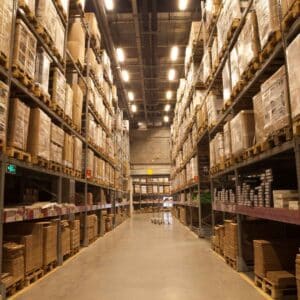The logistics world is changing fast, and warehouses are at the heart of it. With e-commerce skyrocketing and customers expecting lightning-fast deliveries, efficiency is critical. Enter artificial intelligence (AI), a game-changer that’s transforming warehouse management. From predictive analytics to automated sorting and packing, AI is making warehouses smarter, faster, and more reliable. In this article, we’ll explore the role of AI in enhancing warehouse efficiency. AI is revolutionizing warehouse operations, reducing errors, and boosting customer satisfaction.
Why AI is a Big Deal for Warehouses
Warehouses are the engine of the supply chain, but they’re complex to manage. Keeping track of inventory, fulfilling orders, and meeting tight deadlines can be a logistical nightmare. Manual processes are slow, error-prone, and struggle to keep up with today’s demands. AI flips this on its head by using algorithms, machine learning, and real-time data to optimize every step of the process.
AI isn’t just about fancy tech—it’s about solving real problems. It helps warehouses predict demand, automate repetitive tasks, and deliver orders with precision. Let’s dive into the key ways AI is reshaping warehouse efficiency and why it’s a must for modern logistics.
- Predictive Analytics: Mastering Inventory Management
- Automated Sorting and Packing: Faster, Fewer Mistakes
- AI-Driven Robotics: Streamlining the Workflow
- Cutting Errors for Reliable Operations
- Boosting Customer Satisfaction
Predictive Analytics: Mastering Inventory Management
Automated Sorting and Packing: Faster, Fewer Mistakes
Sorting and packing sound straightforward, but they’re time-intensive and ripe for errors when done by hand. AI-powered automation is changing that by making these processes quicker and more accurate. Advanced systems use computer vision and machine learning to handle sorting and packing with precision.
Picture a busy warehouse with a conveyor belt full of packages. AI-equipped cameras scan each item, reading barcodes or QR codes to determine where it’s headed. The system then routes the package to the correct destination, all in seconds. This slashes sorting errors and speeds up order processing, getting packages out the door faster.
Packing is another area where AI excels. Algorithms analyze order details—like item size, weight, and fragility—to determine the best way to pack each box. This minimizes wasted space, lowers shipping costs, and ensures products arrive undamaged. Automated packing systems can also run 24/7, boosting productivity without adding labor costs. For customers, this means faster deliveries and fewer issues with their orders.
AI-Driven Robotics: Streamlining the Workflow
AI isn’t just about crunching data—it’s also about getting physical tasks done. AI-powered robotics, like autonomous mobile robots (AMRs), are taking over repetitive jobs like picking and moving inventory. These robots use AI to navigate warehouses, avoid obstacles, and optimize their paths.
Instead of workers trekking across a massive warehouse to grab items, robots do the legwork. They fetch products and deliver them to packing stations, cutting down on time and effort. This lets human workers focus on tasks that require creativity or decision-making, like quality checks or customer support. The result? Faster order fulfillment and a smoother workflow.
What’s cool about these robots is that they get smarter over time. Machine learning helps them improve their navigation and prioritize tasks as they collect more data. This means warehouses keep getting more efficient, even as order volumes climb. For businesses, this scalability is a lifesaver during peak seasons like holidays.
Cutting Errors for Reliable Operations
Human error is a fact of life in manual warehouse processes. A misread label or misplaced item can lead to delayed shipments or wrong orders, which can tank customer trust. AI steps in to minimize these mistakes, making operations more dependable.
For instance, AI-powered inventory tracking systems use real-time data from RFID tags or IoT sensors to monitor stock levels and locations. If an item is misplaced, the system catches it right away, preventing problems down the line. Automated sorting and packing systems also double-check orders to ensure accuracy.
Fewer errors mean fewer returns, fewer complaints, and more satisfied customers. For warehouses, this reliability builds trust with partners and keeps operations running smoothly, even under pressure.
Boosting Customer Satisfaction
Warehouse efficiency isn’t just about saving time or cutting costs—it’s about delivering for customers. AI makes this happen by ensuring orders are accurate, shipments are fast, and products are available when needed. When customers get what they ordered, on time, they’re more likely to keep coming back.
Take demand forecasting. By predicting what customers will want, AI helps warehouses avoid stockouts that lead to lost sales. Automated systems speed up order processing, so packages arrive sooner. And because AI reduces errors, customers are less likely to deal with wrong or damaged items.
AI also improves customer service. Natural language processing (NLP) tools can analyze inquiries and provide instant updates on order status, saving time for both customers and staff. In a world where customer expectations are sky-high, AI gives warehouses the edge they need to deliver exceptional experiences.
What’s Next for the Role of AI in Enhancing Warehouse Efficiency?
AI is already making waves, but the future is even more exciting. Emerging technologies like AI-driven predictive maintenance could keep warehouse equipment running smoothly. By analyzing sensor data, AI can predict when a machine might break down and schedule fixes before it happens, cutting downtime and costs.
Another frontier is “digital twins”—virtual models of warehouses that let managers simulate and optimize operations. Want to test a new layout or process? A digital twin can show how it’ll play out without disrupting real-world work. These innovations promise to push warehouse efficiency to new heights, keeping logistics ahead of the curve.
Why AI Matters for the Future of Logistics
AI is no longer a nice-to-have—it’s a must for warehouses looking to stay competitive. By optimizing inventory, automating tasks, and reducing errors, AI drives efficiency at every level. For businesses, this means lower costs, faster deliveries, and happier customers. For the logistics industry, it’s a chance to rethink how warehouses operate in a digital age.
Whether you’re running a small operation or a global supply chain, AI offers tools to tackle today’s challenges and prepare for tomorrow’s. It’s not about replacing people—it’s about empowering them to work smarter. As AI continues to evolve, warehouses that embrace it will lead the way in efficiency and innovation.
Final Thoughts On the Role of AI in Enhancing Warehouse Efficiency
AI is transforming warehouse management, from predictive analytics to robotics and beyond. These technologies streamline operations, cut errors, and put customers first, making warehouses more efficient than ever. As the logistics world keeps evolving, AI will be the key to staying ahead.
Want to learn more about how AI can supercharge your supply chain? Stay tuned for the latest trends and innovations in warehouse management. The future of logistics is here, and it’s powered by AI.




